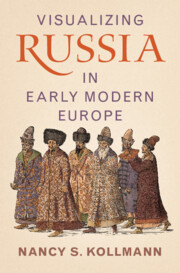Book contents
- Visualizing Russia in Early Modern Europe
- Visualizing Russia in Early Modern Europe
- Copyright page
- Dedication
- Contents
- List of Figures
- Preface
- Introduction
- Part I Encountering Russia Visually
- Part II Sigismund von Herberstein
- 3 Rerum moscoviticarum commentarii (1549) as Humanist Chorography
- 4 Herberstein’s Use of the Visual
- Part III The Muscovy Company Maps Eurasia
- Part IV Visuality Explodes
- Part V Adam Olearius
- Conclusion
- Bibliography
- Index
4 - Herberstein’s Use of the Visual
from Part II - Sigismund von Herberstein
Published online by Cambridge University Press: 31 August 2024
- Visualizing Russia in Early Modern Europe
- Visualizing Russia in Early Modern Europe
- Copyright page
- Dedication
- Contents
- List of Figures
- Preface
- Introduction
- Part I Encountering Russia Visually
- Part II Sigismund von Herberstein
- 3 Rerum moscoviticarum commentarii (1549) as Humanist Chorography
- 4 Herberstein’s Use of the Visual
- Part III The Muscovy Company Maps Eurasia
- Part IV Visuality Explodes
- Part V Adam Olearius
- Conclusion
- Bibliography
- Index
Summary
Chapter 4 explores how Sigismund von Herberstein used the visual in his travel account. Working with an accomplished engraver from Nuremberg, Augustin Hirschvogel, Herberstein devised relatively few illustrations for his account. But they were carefully linked to his text and proved widely influential. His portrait of Vasilii III shows evidence of Hirschvogel’s Habsburg portraits done in Nuremberg, but reflects Herberstein’s acquaintance with the Grand Prince. Perhaps most important was Herberstein’s map (1546), considered for the next few decades the most accurate map of Muscovy. The chapter then explores the imagery that Herberstein added in subsequent editions and concludes by tracking how his text, map and imagery traveled into new, sometimes pirated, editions and locations after his death in 1566.
- Type
- Chapter
- Information
- Visualizing Russia in Early Modern Europe , pp. 82 - 116Publisher: Cambridge University PressPrint publication year: 2024

